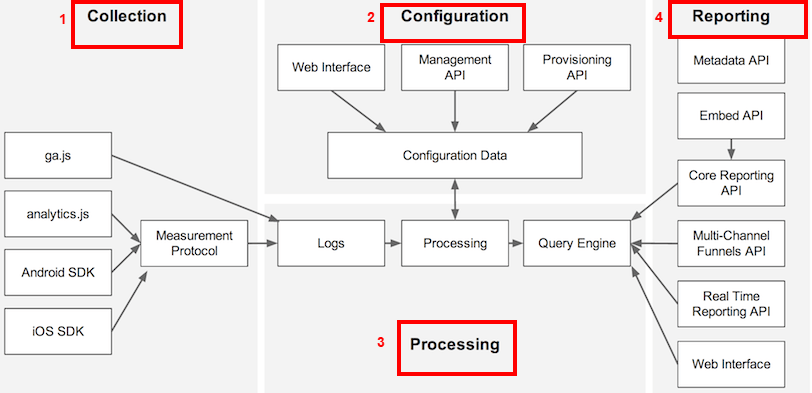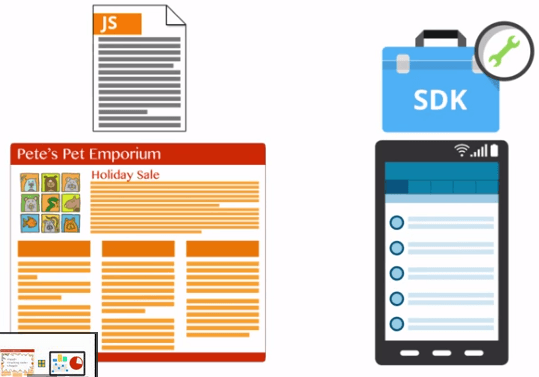Most of us, nowadays , are using maps to get the right directions with minimum troubles when we’re trying to head to a destination. Also, most of times we are using user guides or manuals when we are trying to figure out and to overview how things are working with a certain system, tool, machine or hardware just a few examples to mention.
This post is designed to identify and to overview –without complications – the four components that form Google Analytics, in addition to overviewing how those four components are working together nicely to generate required data that we need to meet our online marketing goals.
The recipe of the valuable reports that we see on our Google Analytics is made up of :
Four Main Components of Google Analytics :
1. Collection
2. Configuration
3. Processing
4. Reporting
For your better reading experience, I preferred to discuss each of the four main components of Google Analytics in separate posts. So, stay tuned! Let’s begin with the first main component of Google Analytics: Collection.
Here are post shotcuts to other main components of Google Analytics:
Part-2 : Processing and Configuration in Google Analytics
Part-3 : Reporting In Google Analytics
1- Collection :
Collection of data makes up the first one of the four main components that Google analytics depends on to generate reports. Google analytics is a powerful platform as it helps you to collect and measure user engagements and activities across different devices and environment.
Google Analytics lets you collect users interactions if you own websites, Android, iOS, or any digitally connected environment, for example a point of sale system or a Kiosk.
Let’s explain in little more details
I – Collection of website data:
If you would like to track a website, you should generate a small piece of JavaScript code in order to gather information. The code is easy to be set up on Google Analytics interface. Only you will need to follow simple and easy steps to have that snippet.
When you are done with setting up the web-tracking code, you are going to copy and paste that code into every page of your website. Two things you should do keep in mind:
- Place the code in the header, i.e. before the closing </head>. Why? To ensure that browser rendered and run the code to capture users even if they tend to leave before the page fully loaded.
- The code should be located in every page. (if you want to collect meaningful and correct information)
<!-- Google Analytics --> <script> (function(i,s,o,g,r,a,m){i['GoogleAnalyticsObject']=r;i[r]=i[r]||function(){ (i[r].q=i[r].q||[]).push(arguments)},i[r].l=1*new Date();a=s.createElement(o), m=s.getElementsByTagName(o)[0];a.async=1;a.src=g;m.parentNode.insertBefore(a,m) })(window,document,'script','//www.google-analytics.com/analytics.js','ga'); ga('create', 'UA-XXXX-Y', 'auto'); ga('send', 'pageview'); </script> <!-- End Google Analytics -->
Tips:
- UA-XXX-Y is your unique property Id. You are going to need it if you are going to use Google Tag Manger or WordPress Analytics Plugins. ( Think of it like a person ID)
- analytics.js means you are using the newest version of Google Analytics that called” Universal Analytics”. ( Not the classic Google Analytics :(ga.js) )
- pageview means the snippet is firing ”pageviews hits” on the pages that being tracked. That is the basic. You can customize Google Analytics JavaScript as per your needs to track more insightful data in your website like for example implementing Display Features.
- Tracking Code above is executed asynchronously which means the code is working hard in the background while the browser is reading the page.
- With Google Analytics website tracking, data is being sent to the collection Google Analytics servers in real time.(#Mobiles uses dispatching – see below)
- The Tracking Code can be customized if you look into collecting additional information about your website users.
The above basic Google analytics JavaScript is able to collect many information about your users. The code is working on your website 24/7 – 365 days a year to deliver intelligent information about every single visit that your website had.
To explain more, that piece of code (without further customization) is capable of collecting and recording information related to the behavior, language, location, technology, devices etc. of your website users.
If you are looking to collect more and more data about the usage of your website, you can customize the above JavaScript snippets to measure what you might think beneficial to your reports. For example, with further customization, you can collect data across domains; you can set custom Dimensions and Metrics; you can measure Event Tracking and Social Interaction; you can set User Timings and/or User ID etc.
Note here that Google Analytics never collects and delivers any personally identifiable information in its reports such as names, IPs. It is completely prohibited. That is against Google Analytics policies.
II – Collection of Mobile Application data
As we said before, Google Analytics is able of collecting data across many devices and environments. Said that, the way to implement the code and how data will be collected will differ from website tracking. The collection process is different in measuring interactions on Mobile app from websites. Mobile tracking – opposed to website tracking that use JavaScript – uses SDK (Software Development Kit) to collect user engagements on a certain operating system.
You may need a good developer to set SDK for you as the process is more complicated than setting Google Analytics JavaScript on websites. If you have good coding skills, you can check Google Developers.
Tips:
- There are two SDKs. One is for Andriod and other one for iOS.
- Collection of mobile data uses Dispatching which means the data is stored for an amount of time to be re-sent later as ”hits” to Google Analytics Servers.
- Dispatching time may vary. Automatically, it is set for 30 min on Andriod devices and 2 min for iOS. The timings can be customized on the tracking code(SDK) to suit your mobile battery life.
- SDKs are customized to track more information about your visitors.
Overview:
That’s it. As you can see the way Google Analytics collects data is greatly determined via how you set up the code, where and which devices. Website tracking code enables JavaScript to collect valuable data about users activities without any customization. On other hands, Google Analytics mobile SDKs offer an intelligent way to track users who are using Androids or iOS devices.
Next post will aim to explain how Google Analytics configure raw data to process it to appear the way it looks in our reports.
I hope you found the information on this article useful. If you have any comments please do not hesitate to share them.

 English
English  German
German Russian
Russian

Nice and deep Info about interface, thanks.
Hi Kanishk,
Thank you for the comment. Keep reading.
Regards,
Omar
In first part you are discussed about how it works on websites to collect useful data. In second part (ie.) in mobiles what are all the informations it collects about?? what is meant by SDK,is it a type of app or neccessary software for mobile operation?? in which way, these informations are useful for the person who collected it?? pls clarify it.
Hi Harish,
Thank you for your question. This is the answer to your question: Sdk is defined as “A software development kit (SDK or “devkit”) is typically a set of software development tools that allows the creation of applications for a certain software package, software framework, hardware platform, computer system, video game console, operating system, or similar development platform.” quoted from Wikipedia
In other words, if a website can be tracked using a tracking snippets, mobile apps are using sdk technology to do the function of tracking.
I do hope I answered your questions.
Best,
Omar Belkadi
My brother recommended I would possibly like this blog. He was once totally right. This put up actually made my day. You can not believe just how much time I had spent for this info! Thanks!